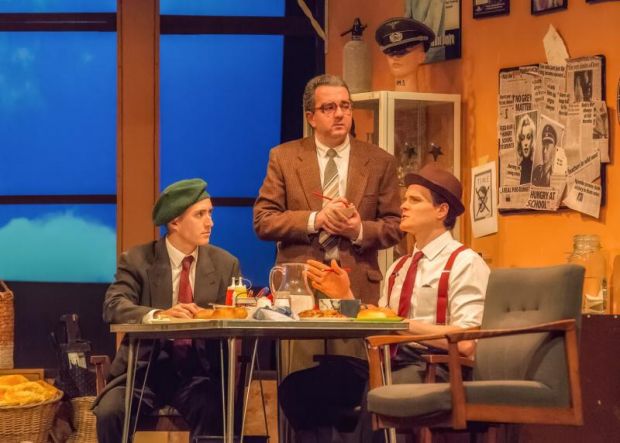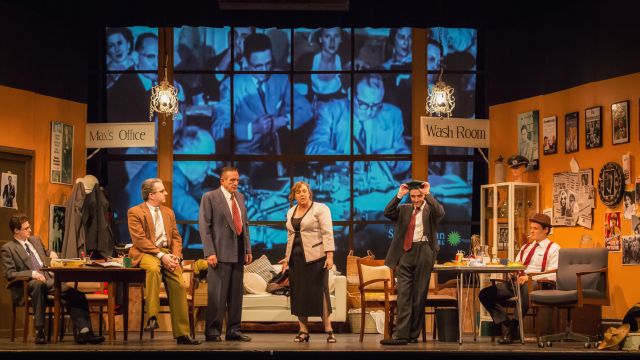Laughter On the 23rd Floor
Writer of more than 30 plays and screenplays, Neil Simon received more combined Oscar and Tony nominations than any other writer, and his 27th play, Laughter on the 23rd Floor was written in 1993. Simon is renowned for his comedy writing, but we should remember that he also won a Pulitzer Prize for drama with Lost in Yonkers, a follow up to his autobiographical trilogy about being born and raised in a poor Jewish home in the Bronx. Critics and scholars have put him in the same category as Ben Johnson, Moliere and George Bernard Shaw, with some describing him as ‘the Shakespeare of his time’.
What makes him unique is the conscious lens he used to celebrate imperfect, decent human beings, many of whom are Jewish, using wry humour and memorable one-liners. He is celebrated for writing that is based on “cleverly poking fun at himself and at his Jewish culture as a whole", based "extensively on his own life and experience." He is also beloved for his great compassion and for being a voice for the silent majority.

A child of Jewish parents, raised in a home where they constantly ‘battled’, his writing reflects a deep understanding of human challenge and emotional suffering. A quiet, shy boy, he was never going to be an athlete or scholar, and Simon began his career as a writer when he joined his brother, Danny Simon, writing radio and television scripts, under the tutelage of radio humourist Goodman Ace, for CBS. This led to other writing jobs, eventually in the writing team of the popular television comedy series Your Show of Shows. The program received Emmy Award nominations for Best Variety Show in 1951, 1952, 1953, and 1954, and won in 1952 and 1953 and it is this period of his life that provides the real life layer of Laughter on the 23rd Floor, the current Adelaide Rep end of year production.
Before the show begins we are accosted by two very ‘pushy’ cleaners, aka Adelaide theatre favourites Rose Vallen and Penni-Hamilton Smith, who quickly tired of helping seat audience members, only to re-appear doing a joyful comedy two-hander audience ‘warm up’ routine on stage, also rehearsing the audience in the responses for the Applause sign. This is a stroke of genius and has the audience enthusiastically clapping actor entrances with Pavlov conditioning like precision. The audience are in the mood for a night of laughs from the outset.

The play focuses on a Sid Caesar (who we meet in a fabulous series of out takes on a wonderful giant size back projection) like character called Max Prince. In this show, he is played as a very non Jewish Italian style character, replete with gold jewellery, by Gavin Cianci. As Max, Cianci is commanding, has stage presence and good comedy timing, but his departure from Isaac Sidney Caesar’s style and ethnicity was a little jarring for me. Max is the star of a weekly comedy-variety show circa 1953, and his staff, including Simon's alter-ego Lucas Brickman played with warmth, gentle maturity and style by Robert Baulderstone, who maintains a running commentary on the writing, fighting, and wacky antics which take place in the writers' room. His narrating is poignant and well-paced and Director David Grybowski has used the authentic ‘front on’ style of television of that period, enabling the whole cast to connect powerfully with the audience.
Max has an ongoing battle with NBC executives, who fear his humour is too sophisticated for Middle America. It also ‘sails very close to the wind’ in the film, television and stage world, where American ethnicities, and attitudes toward women are explored in times in the firm grip of Joseph McCarthy and the political and social undercurrents of its time, potential destruction and real control of these industries.

Grybowski has put together a tight and cohesive ensemble and their elated shared smiles at the Curtain Call attests to this, they too are having a ball. The cast performances are well balanced and believable and despite Simon being very pre women, the smaller roles of the writing team Secretary Helen, played by Lauren Weber and writer Carol, played by Jo Coventry reflect the reality of women’s work in the early 1950’s. Weber and Coventry were convincing in context, with both having meatier characterisation and dialogue opportunities in the second half of the play.
Andrew Horwood as the hypochondriac Ira Stone delivers an older man whose seniority accords him special treatment. Stone has, or might possibly have every conceivable disease known and those diseases move seamlessly across every part of his self-proclaimed raddled body. Fortunately, he knows, and shares the name of every Specialist Doctor in the business. His physical comedy is effortless and his pace is excellent; his altercations with others are both entertaining and important windows into the machinations of the team.

Frank Cwertniak as the dour and witty Russian uses every opportunity well, and Thomas Filsell as the aspiring Hollywood writer uses his Irish accent to good effect. It appears however that Filsell, tasked with smoking throughout (and, spoiler alert, later paying the smokers price), appears not to be a regular smoker, appearing awkward and unsure with the pre-requisite 50’s prop in literary circles, the ever burning cigarette. Speaking of which, the Camel cigarette ad, the preferred cigarette of 1950’s Doctors, used to usher in the Interval was very clever and o so apt. As Max’s confidante, Anthony Vawser does not have many opportunities, but by using one powerful speech, he validates the importance of this role in the story.
The comedic standout is Chris Gun as Milt. A deeply troubled and insecure lothario, he is animated, energetic as has the facial engagement style of Harpo Marx. He relishes the physical comedy, literally leaping and darting around, portraying a restless energy and childlike enthusiasm. OK, so he may be guilty of upstaging, but the fun that he contributes, ensures that he is forgiven.

Plays exist because of hard working production teams and Richard Parkhill and his protégé Harry Ferguson, light this show very well. It is bright, cheerful, and every nuance and corner of the stage can be clearly seen. I loved Brendan Taggert’s sound and projection work, particularly the clever introduction of street noise when the 1940’s style multi-pane windows were opened. The set by the late Ole Wiebkin and Grybowski is wonderfully cluttered, colourful and entertaining on its own right, despite some pieces of dressing being post 50’s. Gilian Cordell has created a suggestion of the era with the costumes and whilst, as Community theatre, with its limited resources, dictates the use of 80’s double breasted suits for a 50’s look, the clever use of items including braces and sock garters made the look believable. The women’s clothing, footwear and grooming is less consistently 1950’s, but is not distracting.
This play is sometimes criticised as being possibly unrelatable for younger generations because of the political and characters of the time references and links. My 14-year-old theatre companion, a seasoned theatre goer disagrees, pointing out that this show is a night of fun and comedy suitable for people of different ages and experience. I have to agree, I left this show chuckling.
Jude Hines
Subscribe to our E-Newsletter, buy our latest print edition or find a Performing Arts book at Book Nook.

